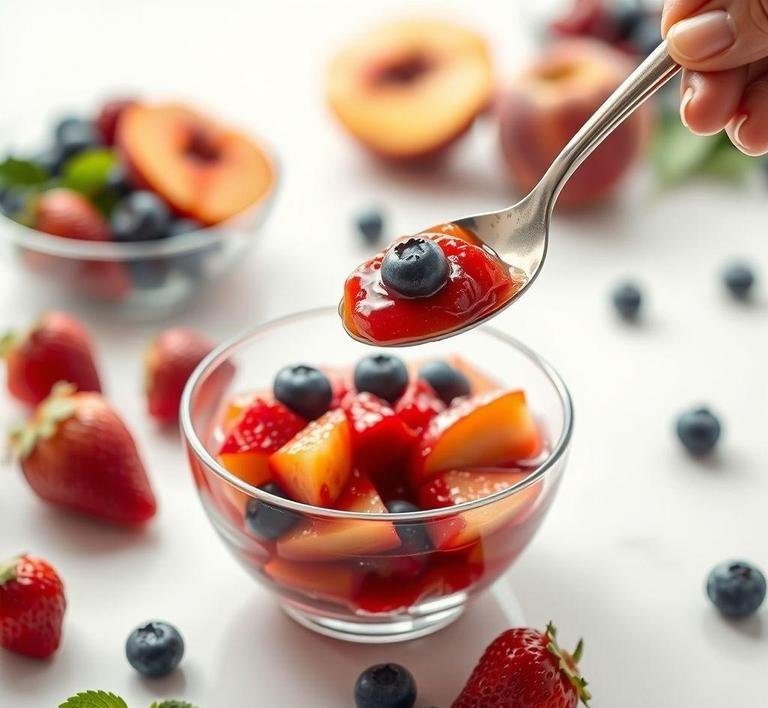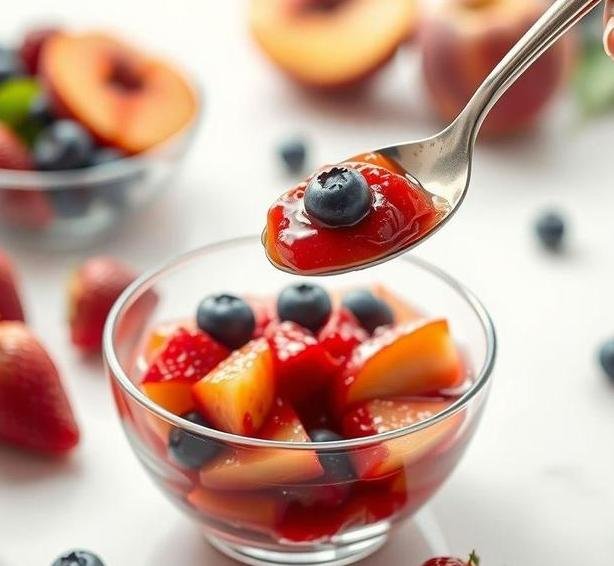Mary Berry’s Fruit Compote is a delightful and easy-to-make dessert or side dish that combines the freshness of seasonal fruits with a touch of sweetness and a hint of citrus. Mary Berry, the beloved British baker and television personality, is known for her traditional yet modern recipes, and her fruit compote is no exception. It’s a versatile dish that can be served on its own, paired with yogurt, cream, or custard, or even used as a topping for cakes, pancakes, or ice cream.
The beauty of this compote lies in its simplicity – no complex techniques or exotic ingredients are needed. It’s a dish that showcases the natural flavors of the fruit, enhanced just enough with sugar and perhaps a splash of orange juice or zest. The result is a light, refreshing treat that can be enjoyed throughout the year by using whatever fruits are in season.
The texture of the compote is also key to its charm – the fruits are gently simmered until tender but not mushy, retaining their shape and a burst of natural sweetness in every bite. The compote is as much about the contrast of flavors and textures as it is about the simplicity of the ingredients.
Mary Berry’s Fruit Compote Recipe
Ingredients Needed

The ingredients for Mary Berry’s Fruit Compote are easy to find and often include fruits that you might already have in your kitchen. Here’s a basic rundown of what you’ll need:
- Fresh Seasonal Fruit – The main element of any fruit compote, the type of fruit you choose depends on what’s in season. Typically, berries such as strawberries, raspberries, blueberries, and blackberries are used in the summer, while apples, pears, and stone fruits like peaches and plums are great choices for the autumn months.
- Sugar – A small amount of sugar is used to enhance the sweetness of the fruit, but it’s not meant to overpower the natural flavors. You can opt for caster sugar for a smoother dissolve or brown sugar for a deeper, caramelized flavor.
- Orange Juice – A splash of fresh orange juice brightens the compote, providing a citrusy kick that balances the sweetness of the fruit.
- Orange Zest (Optional) – Adding orange zest can deepen the citrus flavor, creating a more aromatic and flavorful compote.
- Water – A little water is often used to help the fruits cook gently, preventing them from burning and ensuring that the natural juices are released to create a syrupy base.
- Spices (Optional) – For added warmth, you might use a cinnamon stick or a small dash of vanilla extract. These spices are optional, but they can add a lovely depth to the flavor profile of the compote.
Equipment Needed
Mary Berry’s Fruit Compote doesn’t require specialized kitchen gadgets, just a few common pieces of cookware that every home cook should have on hand. Here’s what you’ll need:
- Saucepan – A medium-sized saucepan with a lid is ideal for cooking the fruit. It should be large enough to comfortably hold all the fruit and liquids while allowing room for stirring.
- Wooden Spoon or Silicone Stirrer – For gently stirring the fruit while it cooks. A wooden spoon is gentle and won’t scratch the bottom of your saucepan.
- Measuring Cups and Spoons – To ensure that you’re using the correct amounts of sugar, water, and orange juice.
- Zester or Grater – If you’re adding orange zest to your compote, a fine grater or zester will be useful.
- Sharp Knife and Chopping Board – If your fruits need chopping (like apples, pears, or stone fruits), a sharp knife and sturdy chopping board will help make the prep work easier.
Instructions To Make Mary Berry’s Fruit Compote
Now that you have everything you need, let’s get into the steps to create this tasty, seasonal fruit compote. The process is simple, and you’ll have a delicious, fragrant dish ready in just a short amount of time. Here’s how to do it:
Step 1: Prepare The Fruit
Wash your fruit thoroughly. If you’re using berries, simply remove any stems or leaves. For stone fruits (like peaches or plums), peel and chop them into bite-sized pieces. For apples and pears, peel, core, and chop into small cubes. The key is to keep the fruit pieces relatively uniform in size so they cook evenly.
Step 2: Combine The Ingredients In The Saucepan
Place the prepared fruit into a medium saucepan. Add sugar to the fruit, and pour in the water and orange juice. If you’re using orange zest, now is the time to add that as well. Optionally, you can drop in a cinnamon stick for a warm spice note or a few drops of vanilla extract.
Step 3: Simmer The Compote
Place the saucepan over a medium-low heat. Cover the pan with a lid, leaving it slightly ajar to allow steam to escape. Stir the fruit occasionally to prevent sticking, and let the mixture simmer for about 10-15 minutes, or until the fruit is softened but still holding its shape. You should see a syrupy liquid begin to form as the fruit releases its juices.
Step 4: Taste And Adjust
Taste your compote during the simmering process. If you’d like it sweeter, add a bit more sugar. If you prefer a more tart compote, a squeeze of lemon juice can help balance out the sweetness.
Step 5: Serve
Once the compote has reached the desired consistency and the fruit is tender, remove the pan from the heat. Let it cool for a few minutes before serving. You can serve it warm, at room temperature, or chilled, depending on your preference. Pair it with yogurt, clotted cream, or as a topping for cakes and pastries.
Tips And Tricks
- Use a Variety of Fruits: For a more complex flavor, try combining different fruits. Mixing berries with apples or adding tropical fruits like mango can elevate your compote.
- Don’t Overcook the Fruit: Keep an eye on the fruit as it simmers. You want it to soften but still maintain its shape and texture. Overcooking can turn the fruit mushy, which isn’t what you want for this dish.
- Experiment with Sweeteners: While traditional sugar works perfectly, you can experiment with alternative sweeteners. Honey, maple syrup, or coconut sugar are all great substitutes that will impart their own unique flavor profiles to the compote.
- Spices for Extra Flavor: Adding a pinch of ground ginger or a cinnamon stick can give your compote an aromatic depth. Experiment with different spices based on the fruits you’re using. For example, cardamom pairs well with pears and apples, while star anise can complement stone fruits like peaches and plums.
- Serving Suggestions: Besides serving your fruit compote with cream, yogurt, or ice cream, you can also use it as a topping for oatmeal, pancakes, or waffles for a more indulgent breakfast.
Mary Berry’s Fruit Compote is a versatile, easy-to-make dessert that can be enjoyed in a variety of ways. It allows the natural sweetness of seasonal fruits to shine, while a little sugar and citrus add the perfect amount of balance. Whether served as a side dish, topping, or a standalone dessert, this compote is a true celebration of fresh produce, making it a must-try for any home cook. The simplicity of the ingredients and the ease of preparation make it accessible to both beginners and seasoned chefs alike. So next time you have some beautiful, fresh fruit on hand, give Mary Berry’s Fruit Compote a try – it’s sure to become a beloved addition to your culinary repertoire!
Easy Recipe Variations For Mary Berry’s Fruit Compote

Mary Berry’s fruit compote is a delightful, versatile dish that can be adjusted to suit different tastes, dietary preferences, or seasonal availability of fruits. While the classic recipe often includes a combination of berries, apples, and citrus, there’s so much room for creativity. Here are some easy variations that will allow you to customize this dish to fit any occasion or preference.
1. Tropical Twist Compote:
Add a burst of sunshine to your fruit compote by using tropical fruits like mango, pineapple, and papaya. These fruits are naturally sweet and juicy, offering a refreshing contrast to the more traditional British ingredients. To make this variation, simply swap out the apples and berries for chopped fresh mango, pineapple chunks, and papaya slices. A dash of lime juice and zest can add an extra layer of freshness, while a sprinkle of shredded coconut on top can bring in that tropical vibe.
2. Autumn Spice Compote:
For the cooler months, embrace the warm flavors of fall by adding spices like cinnamon, nutmeg, and cloves to the mix. Apples, pears, and figs are ideal fruits for this variation, as their rich, sweet flavors blend beautifully with the spices. Add a splash of maple syrup or honey to enhance the sweetness naturally. This version is perfect for cozy dinners or as a topping for porridge or oatmeal in the morning.
3. Stone Fruit Medley:
In the summertime, stone fruits like peaches, plums, apricots, and cherries are at their peak. Create a vibrant and juicy compote by using these fruits. Simply pit and chop the stone fruits, and simmer them with a bit of sugar and lemon juice. You can also mix in a handful of raspberries or blackberries for added texture and tartness. This combination pairs wonderfully with grilled meats, as the sweetness of the fruit offers a nice contrast to savory dishes.
4. Berry Bliss Compote:
For those who love berries, a berry-only compote can be an indulgent treat. Use a mixture of strawberries, blueberries, raspberries, and blackberries, which can all be simmered gently with a bit of sugar and lemon juice. To add an extra layer of flavor, consider adding a few sprigs of fresh mint or a splash of vanilla extract. This variation is especially delicious when served over yogurt, pancakes, or waffles.
5. Citrus Zest Compote:
For a more refreshing and zesty compote, you can create a citrus-centric version by focusing on oranges, grapefruits, and lemons. This is especially delightful in the spring and summer months when citrus fruits are at their juiciest. You could even include a few slices of lime or pomelo to make it even more vibrant. A touch of honey and a bit of fresh mint or basil will complement the citrus notes, creating a perfect balance of tangy and sweet.
6. Mixed Berry & Rhubarb Compote:
Rhubarb’s tartness pairs wonderfully with the sweet flavors of mixed berries. Combine rhubarb with strawberries, raspberries, or blackberries to create a compote that has a good balance of acidity and sweetness. This version can be served warm or chilled, and it pairs perfectly with scones or as a topping for a sponge cake or shortcake. The addition of a little brown sugar can give it a richer, more caramelized flavor, enhancing the tang of the rhubarb.
7. Rhubarb & Ginger Compote:
If you’re looking for a more adventurous flavor combination, adding ginger to rhubarb compote will give it a warm, spicy kick. Simply simmer chopped rhubarb with fresh ginger, sugar, and a little lemon juice. This variation works beautifully when served with desserts like meringue or sponge cakes, or even as a filling for pastries.
By experimenting with different fruits and spices, Mary Berry’s fruit compote can easily be transformed into a dish that fits your mood or the season, ensuring there’s always a fresh twist to look forward to.
Storing Leftovers
While it’s tempting to finish a batch of fruit compote in one sitting, leftovers can be easily stored and enjoyed for several days. Properly storing your fruit compote ensures that its fresh, fruity flavors are preserved without losing texture or becoming overly soggy.
1. Refrigeration:
Fruit compote can be kept in the refrigerator for up to 4-5 days. The best way to store it is in an airtight container, which will help to lock in moisture and prevent the fruit from drying out. Make sure the compote has cooled to room temperature before storing it, as hot compote can cause condensation in the container, which might lead to excess moisture and spoilage.
2. Freezing:
If you’ve made a large batch and won’t be able to finish it within a few days, freezing the compote is a great option. Fruit compote freezes well and can last up to 3 months. To freeze, allow the compote to cool completely, then transfer it to a freezer-safe container or resealable bag. Be sure to leave some space at the top of the container to account for expansion as the compote freezes. For optimal quality, it’s best to freeze fruit compote without adding any dairy or toppings, as these ingredients can change in texture once thawed.
When ready to use, simply defrost the compote overnight in the fridge or reheat it on the stove over low heat, stirring occasionally. Note that some fruits, like berries, may become softer after freezing, but the flavors will still be delicious.
3. Reheating:
To reheat your compote, place it in a saucepan over low heat and stir occasionally. If the compote has thickened too much during storage, you can add a small amount of water or fruit juice to loosen it up. It’s important to reheat it gently to avoid breaking down the fruit too much, which could turn it into a mushy consistency.
4. Storing Toppings:
If you’ve topped your compote with things like whipped cream, yogurt, or granola, it’s best to store them separately from the compote itself. These ingredients don’t store as well with the fruit and may lose their texture or flavor when mixed with the warm compote.
By following these simple storage methods, you can enjoy Mary Berry’s fruit compote for days after the initial preparation, and it remains just as delightful.
What To Eat With Mary Berry’s Fruit Compote?
Mary Berry’s fruit compote is a versatile dish that can be enjoyed with a wide range of accompaniments. Whether you want to serve it as a light breakfast, a topping for a decadent dessert, or a side dish with savory meals, this fruit compote can be paired in many creative ways. Here are some delicious ideas for what to eat with fruit compote:
1. Breakfast or Brunch:
Fruit compote can be the star of your morning routine. For a simple, yet satisfying breakfast, serve the compote over a bowl of creamy yogurt or cottage cheese. The tangy yogurt complements the sweetness of the fruit, making for a balanced and nutritious start to your day. Alternatively, spoon it over warm oatmeal or porridge for a comforting, hearty breakfast.
2. With Pancakes or Waffles:
There’s nothing quite like a classic breakfast of pancakes or waffles topped with a generous spoonful of fruit compote. The fruit compote adds a burst of flavor and color to your plate, elevating this breakfast staple into something special. Whether it’s a berry blend or a mix of tropical fruits, this pairing is always a winner.
3. Scones or Biscuits:
For a more traditional British treat, serve the compote alongside fresh scones, clotted cream, and a cup of tea. The light, flaky scones combined with the sweet and tangy compote create a delightful contrast, perfect for afternoon tea or a light snack.
4. With Cake or Pastries:
Fruit compote is a fantastic topping for cakes and pastries. Whether it’s a fluffy sponge cake, a rich cheesecake, or a buttery shortcake, the fruit compote can serve as a refreshing contrast to the dense or creamy texture of the dessert. It can also be used as a filling in tarts or layered in trifles for added flavor.
5. On Ice Cream or Sorbet:
For a light, refreshing dessert, serve fruit compote over a scoop of vanilla ice cream or fruity sorbet. The cold, creamy texture of the ice cream combined with the warm fruit compote creates a perfect balance of flavors and temperatures. It’s a treat that’s both indulgent and refreshing.
6. Pairing with Cheese:
For a more savory twist, fruit compote can pair beautifully with cheese. Soft cheeses like goat cheese, brie, or ricotta complement the sweetness of the fruit, while harder cheeses like cheddar or blue cheese provide a more robust contrast. Serve the compote as part of a cheese board, alongside crackers, nuts, and dried fruits.
7. With Grilled Meats:
Fruit compote isn’t just for sweet dishes; it can also be used as a savory accompaniment to grilled meats. The sweetness of the compote balances the smokiness of grilled chicken, pork, or even lamb. It’s a great way to add a pop of flavor to a savory main dish.
Conclusion
Mary Berry’s fruit compote is a timeless, versatile dish that can be easily customized to suit any occasion or taste. With its endless variations, it’s a recipe that can evolve with the seasons and your creativity. From tropical twists to autumn spice, the possibilities are limitless.
Whether you’re storing leftovers for future enjoyment, pairing it with a comforting breakfast, or using it to elevate a dessert, this compote will never disappoint. Its vibrant flavors and natural sweetness make it a standout dish that can complement both sweet and savory meals, making it an essential addition to your culinary repertoire.
FAQs
What Fruits Can I Use In Mary Berry’s Fruit Compote Recipe?
Mary Berry’s fruit compote recipe is versatile and can include a wide variety of fruits. Common fruits used are berries like strawberries, raspberries, and blackberries, as well as stone fruits such as peaches and plums. You can also add apples or pears for a bit of texture. For the best results, try to use a combination of fruits that vary in sweetness and tartness.
Can I Make Mary Berry’s Fruit Compote In Advance?
Yes, you can prepare Mary Berry’s fruit compote ahead of time. The compote can be stored in an airtight container in the fridge for up to 3-4 days. It may even improve in flavor as the fruits meld together. However, it’s best to serve it within a couple of days to ensure the freshness of the fruit.
Can I Add Spices To Mary Berry’s Fruit Compote Recipe?
Absolutely! Adding spices like cinnamon, vanilla, or even a dash of ginger can elevate the flavor profile of the fruit compote. If you like a bit of warmth, a cinnamon stick or a small amount of ground nutmeg works wonderfully. Be sure to add spices according to your taste preference, as the natural sweetness of the fruits already provides a good balance.


